Moving image is particularly apt to function in a testimonial role. By that I mean it tends to lend a factual relevance to the issue of representation. Whether that’s by way of an interview with a person of interest or a documentary recording of an event or site, the moving image is often deployed to lend a veracity to the subject at hand that most other forms of representation tend to omit in favour of other vantages. Think perhaps of Impressionism’s sensory invocation, no longer concerned with the purely optic veracity of the landscape than instead the immersive experience of an environment. Of course film too can do this, just look at James Benning’s work which is said to “provide a metaphor for being there” precisely because he acknowledges that his view is limited to the partial moment.(1) So there are then limits to this testimonial aspect of moving image, ones that other mediums readily exploit. Indeed we need only recall how refraction breaks open the linear representation of the moving image into a multitudinal plane of association to see how this testimonial aspect might become a generative problem. But the point of this article is to simple look at how the testimonial functions in moving image work and how we might see it operating in other mediums.
The most obvious example to begin with would be Luke Willis Thompson. Recall how his portrait of Diamond Reynolds was posed as a counter image to the cell phone footage of the tragic event that she becomes a first-hand signifier for. Here then, like Thompson’s other work documenting the systemic police violence against people of colour, moving image functions in a testimonial role, providing a supplemental representation that doesn’t just refute the overtly and systemic racism that permeates western society but provides a counter narrative deeply concerned with the autonomy of the subject whose image and subjectivity is taken up, often unwillingly by a discourse that prefers to have nothing to do with them. This laying prone is obviously the testimonial functioning at its most rawest but it is a brilliant example of how effective moving image work, especially when it’s pitted against a representational bias, can be.
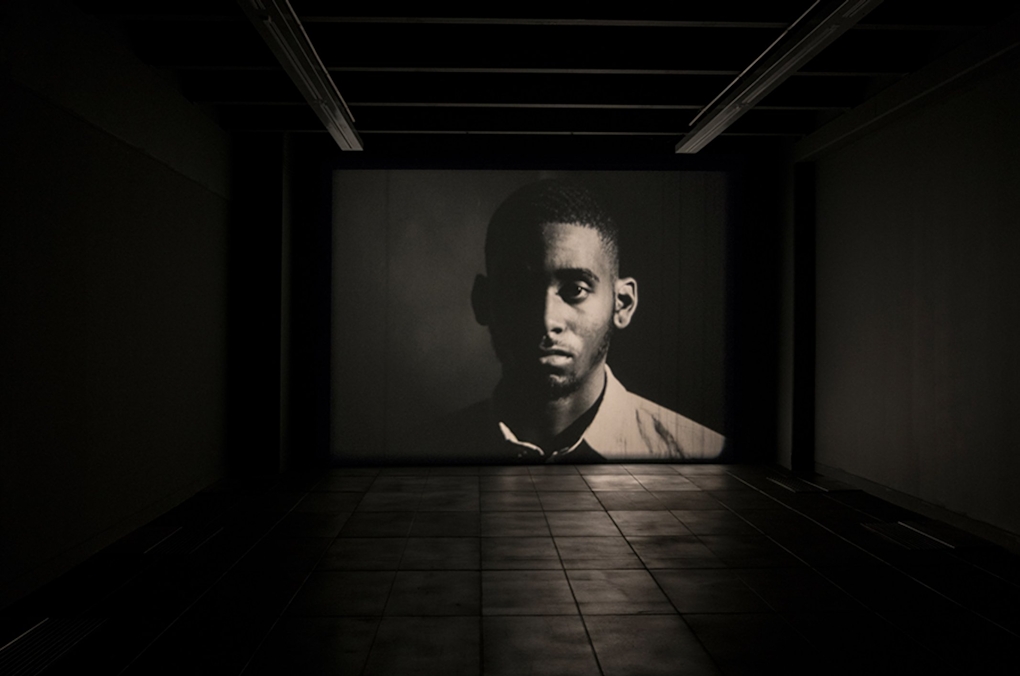
Installation view of Cemetery of Uniforms and Liveries (2016) Luke Willis Thompson, 9min 7sec. 16mm film, b&w, silent; 9.1@16fps, Kodak Tri-X 16mm b&w reversal stock, HD video telecine transfer, Adam Art Gallery Te Pātaka Toi, Victoria University of Wellington, 21 February-15 April 2018. Photo: Shaun Waugh
Clearly then the testimonial has a documentary role. This is clearly evinced by Elisabeth Pointon’s exhibition, would you look at that earlier in the year at play_station. Did this show not rely on the testimonial video that documented that small aeroplane flying her large banner about whose ruse it would seem was entirely metonymic. What else after all would you call this small spectacle, this aeroplane hauling a banner proclaiming the word “spectacular”, only for it to be subsequently decamped and exhibited in the gallery under the title “would you look at that”? Surely this string of self-referencing would seem convoluted at best if it wasn’t wrapped up entirely in the verbiage of exposure, or at least a kind of self-correcting counter-spectacle claiming space from the soft pollution of the advertorial age. Indeed we might think of Pointon’s work here as a testimonial in the best sense, in that it too claims a moment of self-expression from within a system normally rigged for mass-dispersion. This too would explain its self-folding rhetoric, its internalised metonymic string, as a hermetic knot whose redundancy is a corrective appeal for new modes of address. This then is the testimonial functioning in its prevailing logic as a counter-narrative, granting a space in which artists can give voice to the under-represented or under read issues of the day.
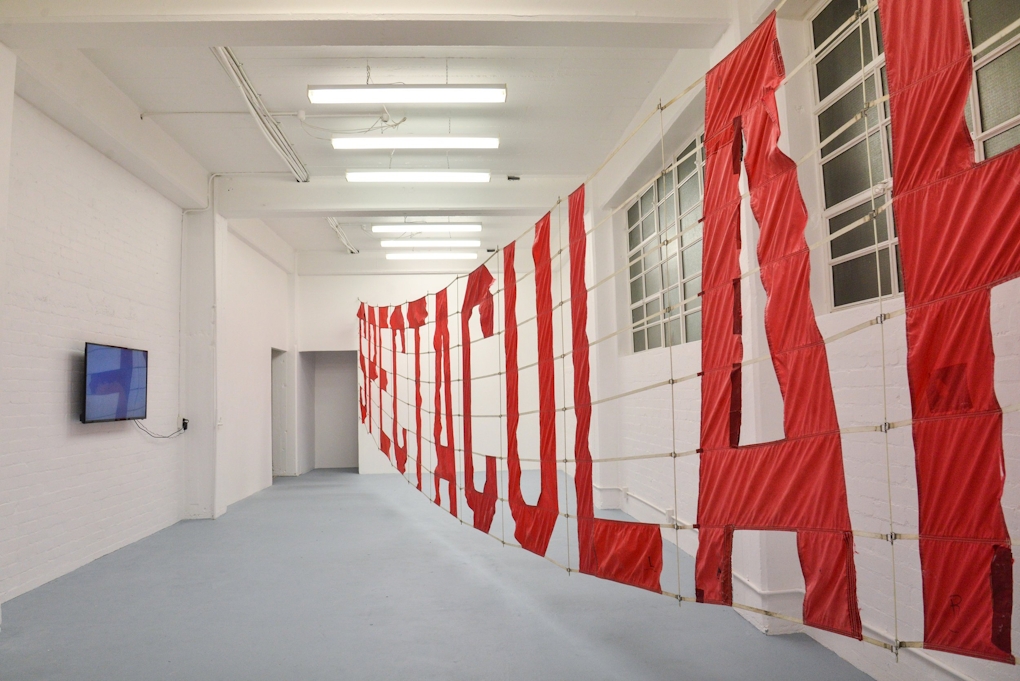
Installation view of Spectacular (2019) Elisabeth Pointon at play_station gallery, Wellington. Photo by Pippy McClenaghan
Obviously then, the testimonial is and should be something treated with respect, if not outright deference. And yet, of course think how quickly such matters become sanctimonious. This is a consideration that explains the humour in Pointon’s metonymic spectacle, a humour that is ably exploited by Max Fleury and Anna Brimer’s recently exhibited video Glory (2019) which documents their improvisational play with a Newtown drinking fountain. The testimony here is slightly slapstick and yet it is no less liberating in its earnestness as a kind of experimental sketching of and for a Newtown fountain. After all if, Cuba Street has its iconic bucket fountain, why not a debris-strewn Newtownian fountain composed from the left over detritus remaindered behind a community centre’s back door? Surely then this slapstick making-do, a taped together assemblage of a fountain, is a less a recording of an event the more it is a kind of provocation, or at the very least an example of the types of jouissance so capably exploited by Kate Newby’s photos of people skimming her stones. Given this we can see how Glory’s testimony might concoct a slapstick inversion of the civic minded proxies of water fountain politics (even at a local level) but also to the improvisational tactics that enliven life in the city on so many other levels.
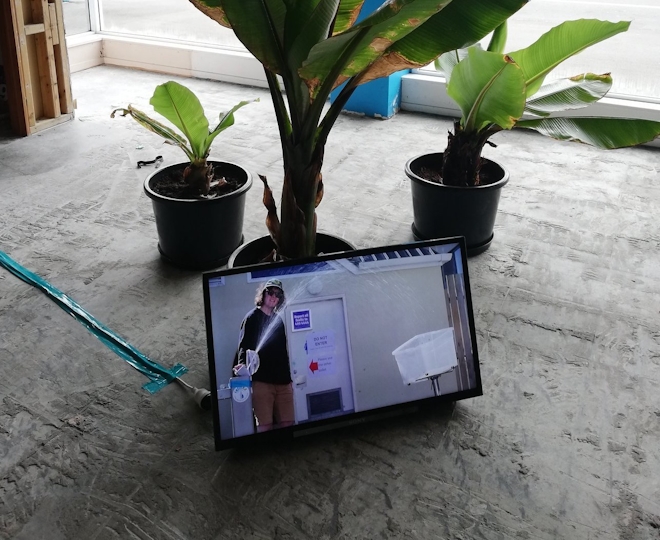
Installation view of Glory (2019) Anna Brimer & Max Fleury. Commissioned by CIRCUIT for AURA Festival, Wellington (2019)
Clearly then the moving image can and has been be relied on to invoke a testimonial role. What then happens when other art-forms are called upon to take up this role? Recall here the role the testimonial object played in 2012’s documenta, whether that was Guillermo Faivovich and Nicolas Goldberg’s attempts to exhibit El Chaco, the second largest meteorite on Earth or the so called Bactrian Princesses (small figurines from second millennia BC). Did these objects not enact a testimony not just of history’s deep time but to the constant evaluation and circulation of such objects throughout culture? Compare for instance these testimonial objects against the Lee Miller photos they were exhibited in close proximity to. Miller’s photographs of her momentary rehabilitation of Hitler’s Munich apartment, pose an entirely different kind of testimony to these historical objects. Perhaps then we might say that those testimonial objects were less about representational maxims as it has been in the previous examples from moving image work, but instead invokes a kind of custodial duress, the emphatic testimonial presence of the object itself which calls care unto itself. Closer to home we can see an extenuation of this logic in the recent show of Fiona Connor which shows brass replicas of ordinary gallery equipment, brooms, chairs, ostensibly around the frame of "being closed for installation".(2) What we get then is a kind of testimonial tableaux, a chair pitched against the wall, the discarded coffee cup, the ear buds, the broom. All are implacable, solid bronze, heavy objects that are almost moribund devices, slightly deadened in their copying. Compare for instance these with previous replications of Connor’s that mimic other sites or apparatuses, none of these objects have ever been cast so solemnly. Perhaps then we might consider these new objects as no longer just copies but memento mori, which deliberately point to the shadow work of gallery installation, that occluded and yet supportive apparatus of any gallery’s daily function. What we get then is a testimonial object that carries with its own duty of care, drawing attention to the other, often occluded roles within the gallery that are normally kept from view.
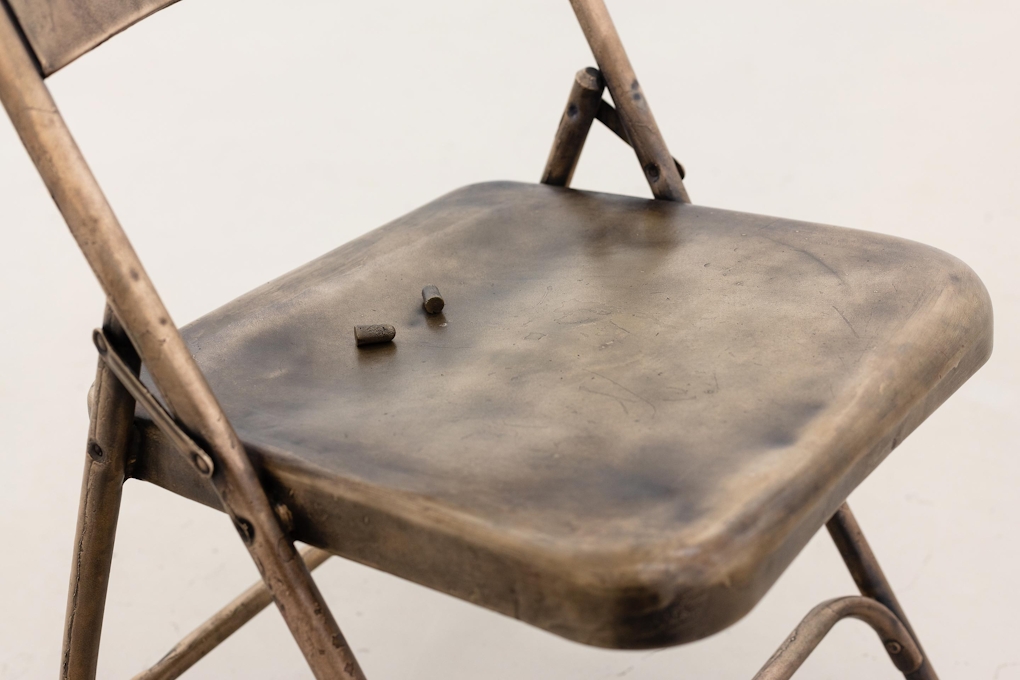
Detail of Closed for Installation (chair, bottle, earplugs) (2019) Fiona Connor. cast bronze, four elements: 735 x 440 x 510mm, 200 x 60 x 60mm, 25 x 10 x 10mm, 25 x 10 x 10mm. Courtesy of Mossman Gallery
If Connor’s testimonial objects mimic functions or roles too often overlooked, whether that’s newsstands, community centre's door-ways, noticeboards, or in the recent instance, gallery installation practices, we still find the testimonial operating as a representational strategy. That is they continue to draw attention to practices or sub-cultures that are often overlooked. Perhaps then we could look to Rob Hood’s use of the object to find a different testimonial vector. Take for instance his Wrecked Kilometre (2008), a collection of broken road side markers that mimics Walter De Maria’s Broken Kilometre (1979). In this work, the object, the broken roadside marker is a testament in itself, marking not only an individualised erratic navigation, but when presented en-masse to the tawdry statistics of Aotearoa’s automobile use. And yet overlaying it onto De Maria’s Broken Kilometre, a spectacular work of minimalisms’ reductive bias, this testimony becomes poetic, no longer so simply a testament to Aotearoa’s road deaths but a constellation of error, echoing the poetically charged work of someone like Jason Dodge who mixes up the object with sentimental labour, like for instance his scarf knitted from the length of wool it would take to reach the outer atmosphere. Likewise then, we can similarly read the Wrecked Kilometre not so much through the specificity of any one particular error, as it is the likelihood of error in any model, making the accidental seem entirely predictable. Which is to say that this model internalises its faults, making it as much a componentry as any other mechanism. This is of course a dispiriting kind of testimony but it is a testament nonetheless.
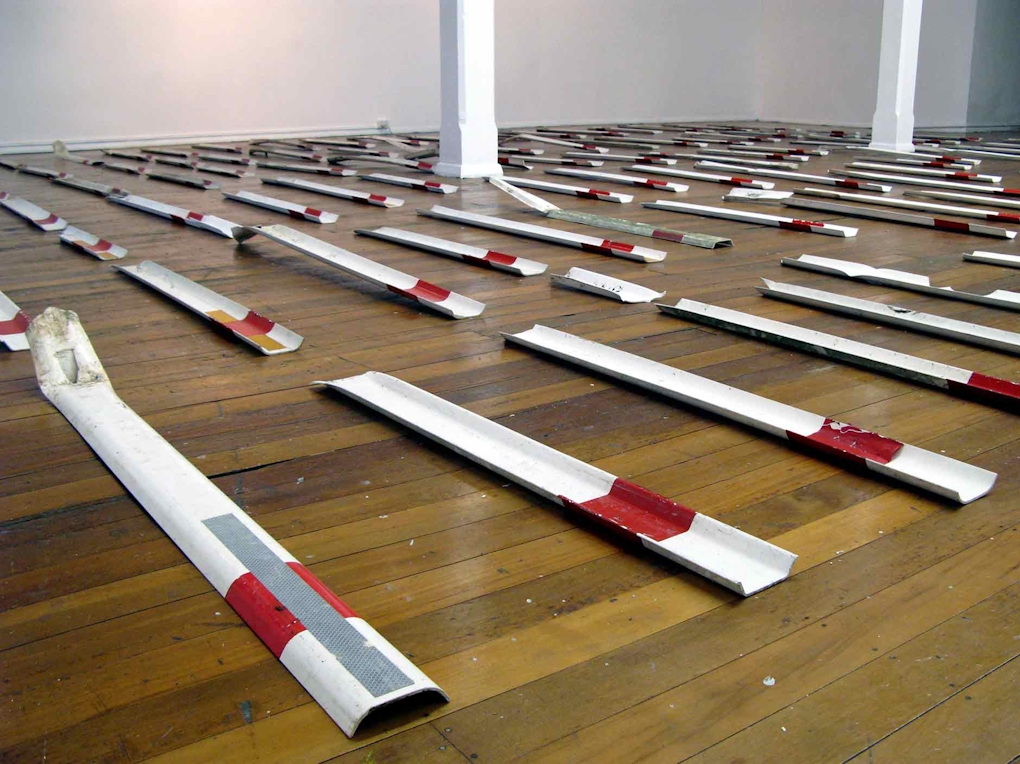
Installation view of Wrecked Kilometre (2008)Rob Hood, Courtesy of Jonathan Smart Gallery
I labour this point over an older work of Hood’s because it’s a convenient way to read his recent work Triple Smoked (2019), a seemingly inexplicable commingling of three kegs. Could we not after all read these as a testament to Aotearoa’s mythological improvisational élan, a kind of vernacular kiwi ingenuity we’d expect someone like Dick Frizzell to elaborate. And yet, couldn’t we say this sculpture poeticises that very testimony. A kind of volk sculpture that is much a sample as it is sampled itself. Is it not, after all, a composite image, much as Max Fleury and Anna Brimer’s improvisation fountain is as well? Surely then the two testimonials overlap, one a recording of an event, the other, a provisional probe-like entity sitting patiently in the gallery. Considering this conflation couldn’t we say that both, Fleury and Brimer’s improvisational fountain, and Hood’s smoker, call up a similar duress of care? Do these works not teeter on the edge, both physically and conceptually. Isn’t it all a little too much? Don’t they both exude a kind of fear, a dadaesque risk, whose “mimetic exacerbation”(3) fosters a testimony too close to home? Surely that’s the reason Fleury and Brimer’s fountain is proposed under the satiric title of Glory. Doesn’t that too make sense of Hood’s smoker being exhibited under the rubric of “future sectional”.(4) If that isn’t enough shouldn’t we heed the image of the flyer for Hood’s show that action shot of a man burnishing chainsaw to tree. Surely this irrevocably calls up the prototypical kiwi image of the burnt tree motif of the 1930s and 1940s through which a settler malaise over the colonial expropriation of nature found voice.(5)
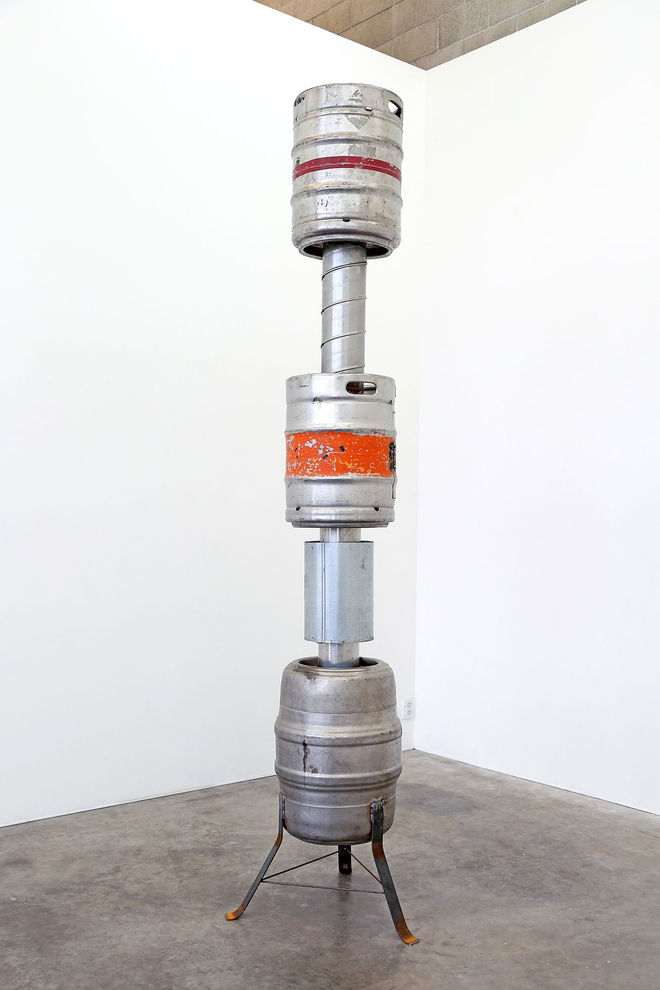
Installation view of Triple Smoked (2019) Rob Hood, Courtesy of Jonathan Smart Gallery
Hood’s work has long mimed a kind of sculptural testimony. Whether it was the commercialised hagiography of his adapted pop star posters who spew an “ectoplasm” composed from commercial plastic shopping bags, or the burnt-rubber tyre marks he photographs in oblique scenic spots. Both are forms of testimony that bring to light the material-commodity culture we live in, but they also highlight the enunciative role such aspirational markings evince. This too can similarly be seen in the centre piece he made for his previous show, Say Valley Maker (2014), at Johnathan Smart in which he repurposed the abandoned furniture of CERA when they finally left the Christchurch Art Gallery building. This deployment of the plethora of expendable lamps, tables, bins, office fans, not only played testimony as a sardonic joke on bureaucratic waffle, especially given their profligate culture, but it also pointed to a larger kind of upcycling testimony. What I mean by that is the work was less some rift on the materialist objects, repurposed as so many ready-mades, but rather a testimonial circulation, and emulatory upcycling whose élan is purposefully on display in Triple Smoked. Which is to again return to that celebratory vernacular idiom of kiwi can-do, whose blunt machinic edge is fully compromised as an insatiable actor entirely out of control. Which is again a dispiriting testimony, but its' repetition makes it an encumbrance almost impossible to avoid.
